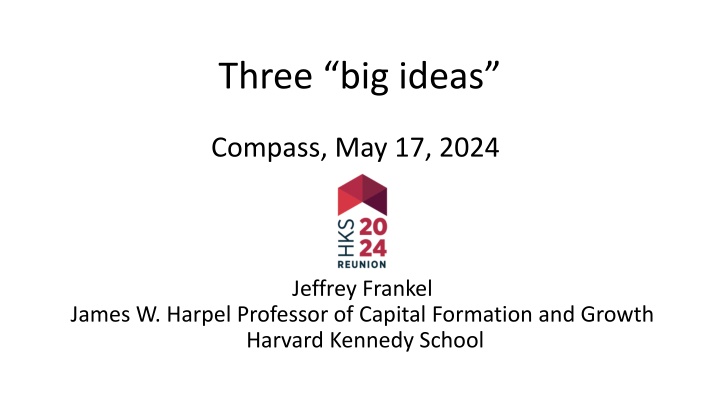
Three Big Ideas: Economic Policy, Signaling in US Foreign Policy, and False Imbalance Syndrome
Jeffrey Frankel and James W. Harpel discuss three pivotal ideas in their presentation, focusing on economic policy maximization subject to constraints, the importance of signaling in US foreign policy decisions, and the syndrome of False Imbalance. They delve into topics such as market optimization, public policy choices, past US interventions, credibility in foreign policy signaling, and the correlation between advance warnings and subsequent actions. Through these three big ideas, they provide valuable insights for policymakers and researchers alike.
Uploaded on | 1 Views
Download Presentation

Please find below an Image/Link to download the presentation.
The content on the website is provided AS IS for your information and personal use only. It may not be sold, licensed, or shared on other websites without obtaining consent from the author. If you encounter any issues during the download, it is possible that the publisher has removed the file from their server.
You are allowed to download the files provided on this website for personal or commercial use, subject to the condition that they are used lawfully. All files are the property of their respective owners.
The content on the website is provided AS IS for your information and personal use only. It may not be sold, licensed, or shared on other websites without obtaining consent from the author.
E N D
Presentation Transcript
Three big ideas Compass, May 17, 2024 Jeffrey Frankel James W. Harpel Professor of Capital Formation and Growth Harvard Kennedy School
Three big ideas 1) Economic policy as maximization subject to constraints 2) Signaling, in US foreign policy 3) The syndrome of False Imbalance.
1) Maximization subject to constraints 1.1 Private markets Objective: Consume plenty of food & clothing food Production constraint A) Markets maximize, subject to constraint, if no market failure. A B) Distortions leave us worse off. E.g., water subsidies B clothing
1.2 Public policy choices Objective: High GDP + a clean environment Clean environ- ment A) Externality: free market gives too much pollution B) 1st best policy: Tax pollution C) Mandate technology => lower GDP and worse environment. E.g., ethanol in gasoline. B D C D) With political constraint => 2nd best: green jobs subsidy A GDP
2) Signaling, in US foreign policy America should more highly correlate its signals of willingness to intervene militarily with actual prospects for intervention. 2.1 Cases where the US government made declarations of resolve that it was ultimately unable to back up: i. Vietnam, 1965-75 ii. Lebanon, 1983-84 iii. Afghanistan, 2001-21 iv. USG called for Ukraine & Georgia to join NATO in 2008. The lesson isn t that the US should have persevered in these cases, but that it shouldn t have staked its credibility in the 1stplace.
Its not just a problem of the US making threats it cant carry out 2.2 There are also cases where it carried out threats that it had neglected to make: i. A few months before North Korea invaded the South in June 1950, Secretary of State Acheson defined the US defense perimeter in Asia without including South Korea. ii. A few days before Iraq invaded Kuwait in July 1990, the US signaled that it would not object.
2.3 Cases where advance signals matched the actual subsequent response i. Aug. 5, 1990 -- After Iraq had indeed invaded Kuwait, George H.W. Bush declared, This will not stand. ii. Jan. 16, 1999 Bill Clinton warned Serbian President Slobodan Milo evi to withdraw from Kosovo. iii. Dec. 2021, Joe Biden warned Russian President Vladimir Putin that, in the event it invaded Ukraine, the US & allies would make Russia pay a heavy price [but he didn t threaten to send US troops].
3) The syndrome of false imbalance, in reporting False Balance takes a debate that is in truth unbalanced & pretends it is balanced, in an attempt to sound impartial. E.g., climate change denial. False Imbalance takes a debate that is in truth balanced, & pretends it is imbalanced.
Three example of false imbalance in reporting 3.1 The Affordable Care Act of 2010 ( Obamacare ). Some media reported that a majority of respondents opposed the ACA -- 62% in a 2013 CNN poll. But many of those classified as opposed thought the law did not go far enough, wanting a single-payer system for health insurance. 3.2 The Fed Reserve is accused of worsening inequality . But some argue that easy money exacerbates inequality because it pushes up the stock market, benefiting the rich, while others think that monetary tightening exacerbates inequality because it raises unemployment.
Lastly, a current example of false imbalance in reporting: 3.3 NYT, April 25, report: Columbia s president is fighting for her job: Nemat Shafik, the university s leader, met privately with faculty members, who could soon decide to admonish her Dr. Shafik, who last week called in the police officers who made more than 100 arrests while they cleared a student protest encampment, is facing mounting calls for her resignation, including from House Speaker Mike Johnson The article nowhere mentions that many critics attack her for being too aggressive in clearing out pro-Palestinian demonstrators, while others attack her for not being aggressive enough! I don t know if she got the balance right, but how is one to judge, if the public debate elides the pros and cons?
Three big ideas 1) Economic policy as maximization subject to constraints 2) Signaling, in US foreign policy 3) The syndrome of False Imbalance. Prof. Jeffrey Frankel
